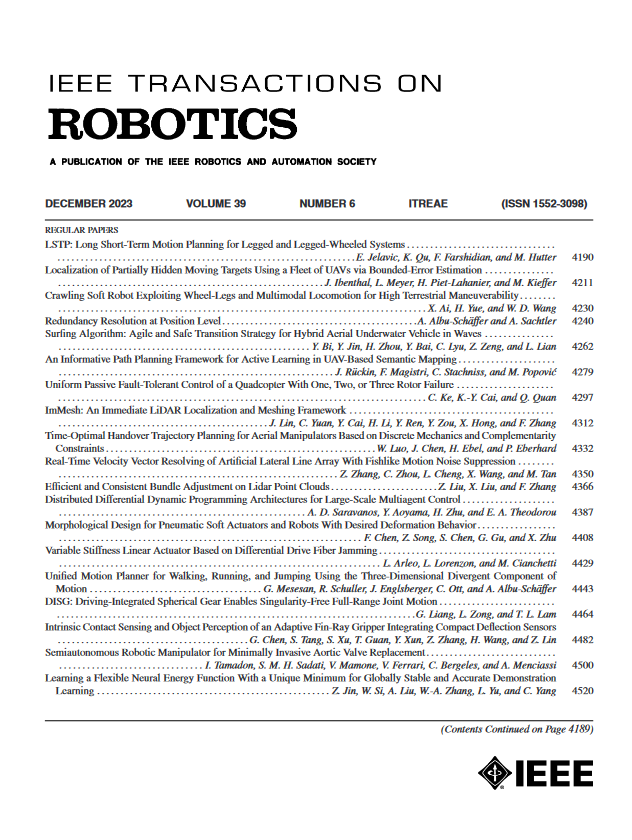基于接触点鲁棒性的稳定物体放置规划
IF 9.4
1区 计算机科学
Q1 ROBOTICS
引用次数: 0
摘要
介绍了一种用于指导机器人在复杂场景中稳定放置物体的规划器。我们提出的方法与传统的物体放置方法相反:我们的规划器首先选择接触点,然后确定一个放置姿势,征求所选点。这是代替采样姿态,识别接触点,并评估姿态质量。我们的算法促进了稳定感知的物体放置规划,对物体形状、凹凸度或质量密度均匀性没有限制,同时避免了组合计算的复杂性。我们提出的稳定性启发式方法使我们的规划器找到解决方案的速度比不使用启发式的相同算法快20倍,比使用传统抽样和评估方法的最先进方法快8倍。与其他五种基准算法相比,所提出的规划器在寻找稳定位置方面也更成功。我们的方法源自第一性原理,并在十次真实机器人实验中得到验证,为刚性物体放置规划问题提供了通用且可扩展的解决方案。本文章由计算机程序翻译,如有差异,请以英文原文为准。
Stable Object Placement Planning From Contact Point Robustness
We introduce a planner designed to guide robot manipulators in stably placing objects within complex scenes. Our proposed method reverses the traditional approach to object placement: our planner selects contact points first and then determines a placement pose that solicits the selected points. This is instead of sampling poses, identifying contact points, and evaluating pose quality. Our algorithm facilitates stability-aware object placement planning, imposing no restrictions on object shape, convexity, or mass density homogeneity, while avoiding combinatorial computational complexity. Our proposed stability heuristic enables our planner to find a solution about 20 times faster when compared to the same algorithm not making use of the heuristic and eight times faster than a state-of-the-art method that uses the traditional sample-and-evaluate approach. The proposed planner is also more successful in finding stable placements than the five other benchmarked algorithms. Derived from first principles and validated in ten real robot experiments, our approach provides a general and scalable solution to the problem of rigid object placement planning.
求助全文
通过发布文献求助,成功后即可免费获取论文全文。
去求助
来源期刊

IEEE Transactions on Robotics
工程技术-机器人学
CiteScore
14.90
自引率
5.10%
发文量
259
审稿时长
6.0 months
期刊介绍:
The IEEE Transactions on Robotics (T-RO) is dedicated to publishing fundamental papers covering all facets of robotics, drawing on interdisciplinary approaches from computer science, control systems, electrical engineering, mathematics, mechanical engineering, and beyond. From industrial applications to service and personal assistants, surgical operations to space, underwater, and remote exploration, robots and intelligent machines play pivotal roles across various domains, including entertainment, safety, search and rescue, military applications, agriculture, and intelligent vehicles.
Special emphasis is placed on intelligent machines and systems designed for unstructured environments, where a significant portion of the environment remains unknown and beyond direct sensing or control.
 求助内容:
求助内容: 应助结果提醒方式:
应助结果提醒方式:


